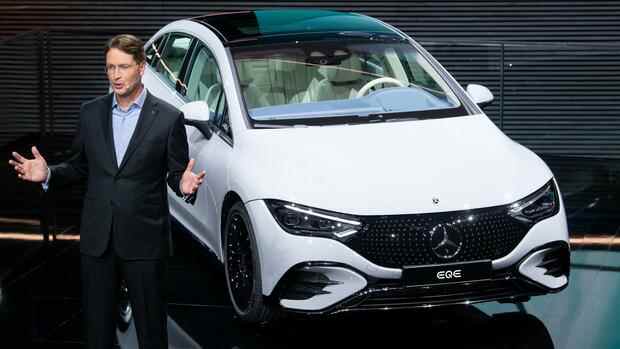Stuttgart Everything based on luxury and strict cost discipline: This course from Mercedes-Benz is paying off. The Stuttgart carmaker reports the best result ever for its business with cars and vans. According to preliminary figures, the Swabians were able to more than double the adjusted operating profit (EBIT) in their core business compared to the previous year – from 6.8 to 14 billion euros. As a result, the return on sales of the brand with the star has reached unprecedented heights and is around 13 percent.
“We continue to implement our strategy at full speed. Our good result is the result of products that are in high demand as well as the focus on profitable growth and cost discipline,” explained Mercedes frontman Ola Källenius. “As the world’s most valuable luxury car brand, we are accelerating into an all-electric, software-driven future.”
At the beginning of his term in summer 2019, Källenius shocked his investors with a series of profit warnings. Now the Swede regularly exceeds his forecasts. The diesel scandal is largely over, the corona pandemic is no longer an operational problem and the lack of semiconductors is causing sales to shrink, but strangely enough it is helping to enforce prices. In other words, Mercedes can charge more money than ever for its cars, not least because of the limited supply.
>>> Read about this: Car manufacturers rely on luxury vehicles – and delete small models
Top jobs of the day
Find the best jobs now and
be notified by email.
The results of Mercedes-Benz Mobility show how well business is going. The financial division of the Dax group reports a massive jump in profits from 1.6 to 3.4 billion euros as a result of a favorable “used car performance”. The division’s return on equity adjusted for special factors is an impressive 22 percent.
The figures were recorded on the stock exchange with a price increase: Mercedes shares rose by up to three percent to 71.77 euros and were thus at the top of the Dax.
Rigorous austerity measures are having an effect
Mercedes frontman Källenius has radically rebuilt the German industrial icon. The truck and bus business (Daimler Truck) was spun off last year and is now listed as an independent company in the MDax small-cap index. At the beginning of February, Källenius renamed the former Daimler AG as the parent company Mercedes-Benz Group AG.
Operationally, Daimler Truck and Mercedes-Benz no longer have anything to do with each other. As a result of the separation of trucks, Mercedes calculates with a one-time profit of nine to ten billion euros, which is added to the adjusted operating result of the car and finance division.
>>> Read about this: Ten facts about the spin-off of the truck division
Nevertheless, from the point of view of the Mercedes board of management, this valuation effect should not be taken into account when calculating the dividend. Or to put it another way: the one-off profit should not be distributed to the shareholders. As a rule, Mercedes shareholders receive a 40 percent share of the group’s profits.
The fact that the Swabians are now so profitable is also due to a tight austerity plan that CEO Källenius and his CFO Harald Wilhelm are consistently pursuing. The two managers want to reduce fixed costs by a fifth by 2025. Thousands of jobs will be cut. Unprofitable models like the B-Class are being removed from the portfolio. Mercedes focuses on class instead of mass. The Stuttgart-based company is now leaving the sales crown in the premium league to BMW and prefers to push the sale of highly profitable sub-brands.
Deliveries from Mercedes-Benz fell by five percent in 2021 due to the lack of chips – to 2.05 million vehicles. But sales of high-end models are thriving. Last year, the brand with the star delivered 87,000 units of its flagship, the S-Class alone. This is an increase of 40 percent compared to the previous year.
DWS: “In three years, a return of 15 percent should be feasible”
The luxury sedan is also in great demand in the particularly elegant Maybach version. Like the sports car subsidiary AMG, Maybach reports a new sales record. The G-Class off-road vehicle, which is often configured with an AMG engine, is so popular that Mercedes recently had to freeze orders for the 2.5-tonne model. Production in Graz has been working to capacity for years to process existing orders.
Overall, Mercedes sells fewer compact cars but more large SUVs and sedans. With the latter, the contribution margins are far higher than with the smaller brands. The better product mix leads to higher profitability.
However, some investors point out that volume manufacturers such as Opel’s parent company Stellantis are currently achieving double-digit returns on sales. One has to place higher demands on a provider of luxury cars, says Michael Muders, fund manager at Union Investment. “The group must have the ambition to show more. In two or three years, a return of 15 percent should be feasible.”
The capital market expert supports the basic strategy of Mercedes boss Källenius. But in order for the luxury focus to catch on in the long term, the Swede must ensure that the cyclical nature of the car business disappears. “Mercedes’ margins must no longer collapse in unison with every major economic downturn, as they used to. The group must remain lean and profitable.”
Mercedes intends to present its full balance sheet for the 2021 financial year on February 24. Analysts and investors will then pay particular attention to the forecast for the current year, i.e. whether the Swabians will be able to maintain or even expand their record margins in 2022.
More: The luxury strategy of Audi, BMW and Mercedes could take revenge
